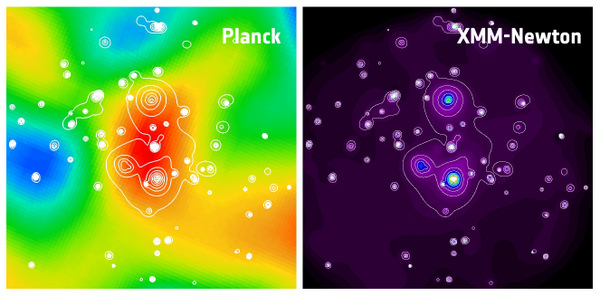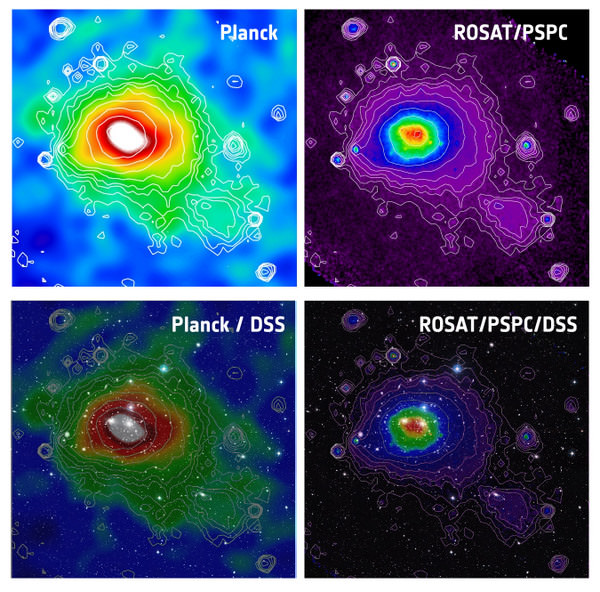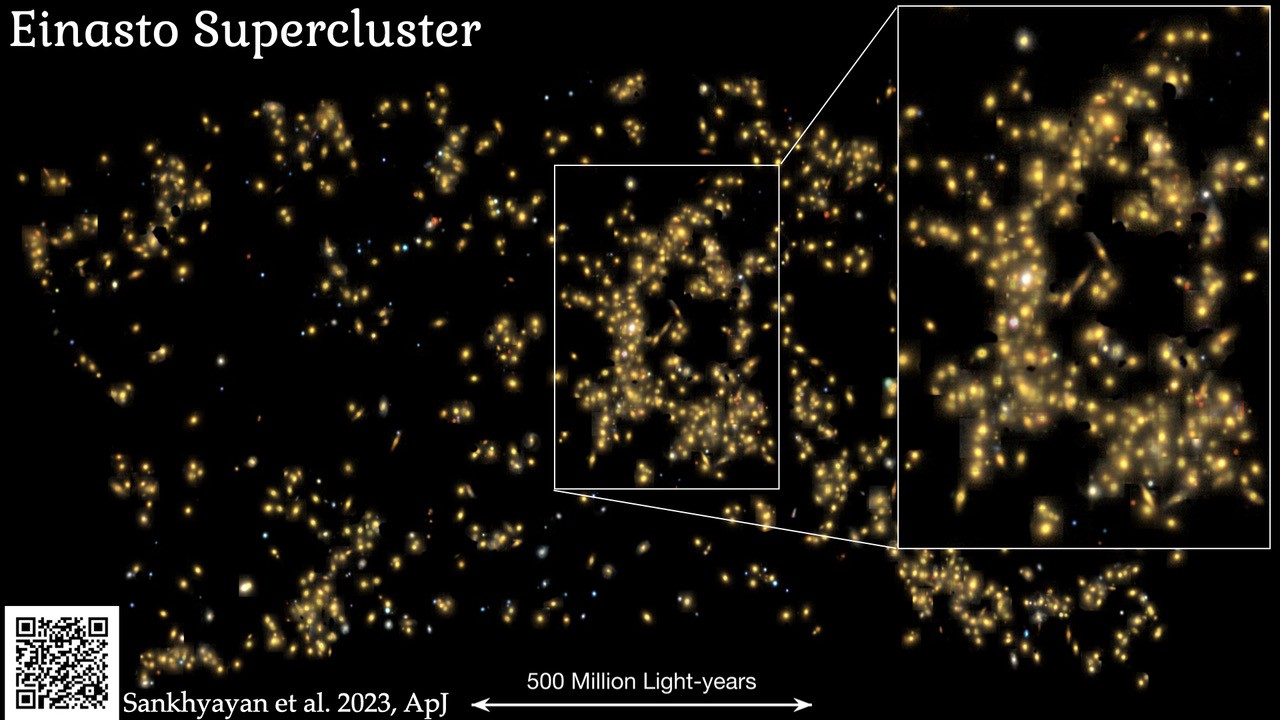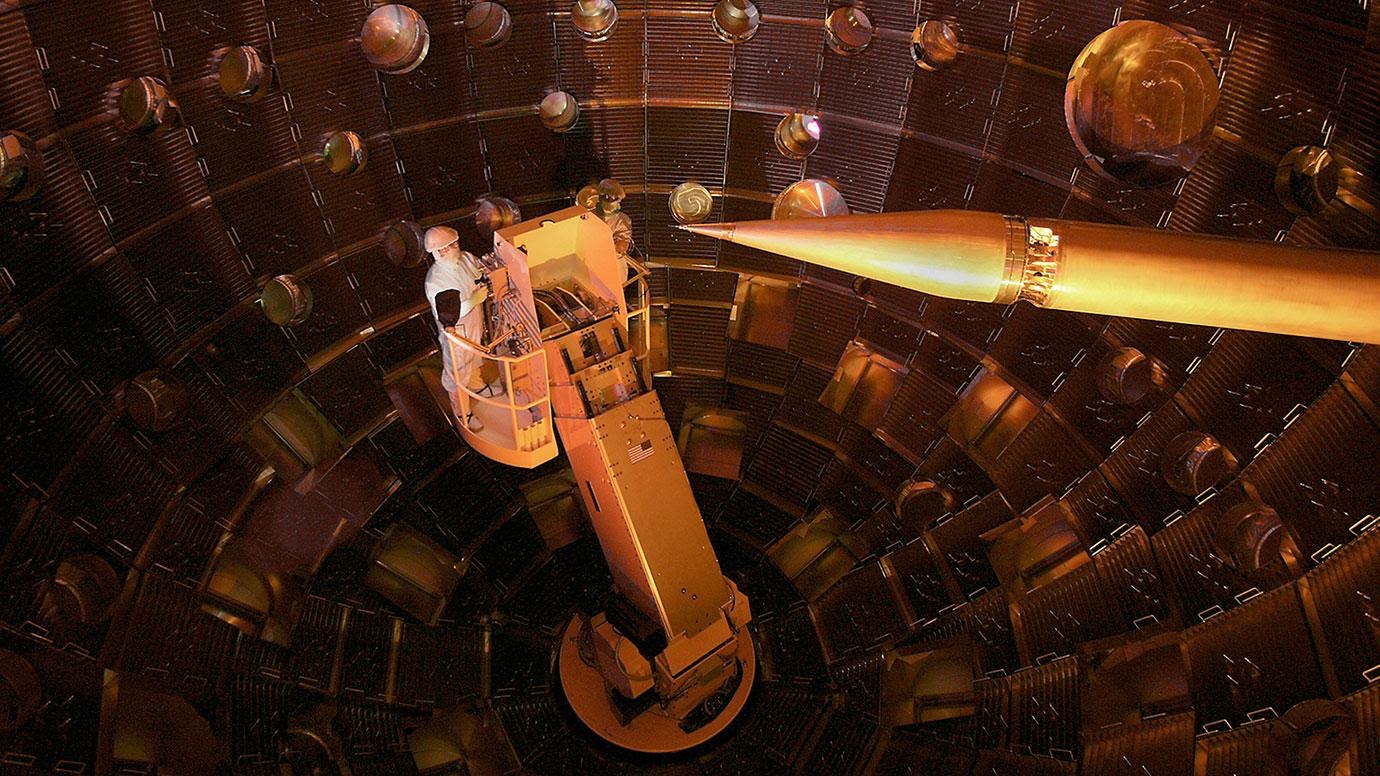The Earth’s place in space is a fairly familiar one with it orbiting an average star. The star – our Sun – orbits the centre of our Galaxy the Milky Way. From here onwards, the story is less well known. The Milky Way is part of a large structure called the Laniakea Supercluster which is 250 million light years across! That really is a whacking great area of space and it contains at least 100,000 galaxies. There are larger superclusters though like the newly discovered Einasto Supercluster which measures an incredible 360 million light years across and is home to 26 quadrillion stars!
Continue reading “Astronomers Find the Most Massive Supercluster to Date”This Tiny Dot is one of the Biggest, Most Active Galaxy Superclusters Ever Seen. It Was Already a Monster Shortly After the Big Bang

A newly discovered supercluster of galaxies is so distant that astronomers say its light has been traveling for over twelve billion years to reach telescopes on Earth. But this cluster, named SPT2349 ?56 is gigantic, and so old that it is actually classified as a proto-cluster of galaxies, meaning it might be one of the earliest large clusters of galaxies in our Universe. It is also one of the most actively star-forming proto-clusters known.
Continue reading “This Tiny Dot is one of the Biggest, Most Active Galaxy Superclusters Ever Seen. It Was Already a Monster Shortly After the Big Bang”Lasers Recreate the Conditions Inside Galaxy Clusters
Galaxies don’t exist in a vacuum. Ok, maybe they do (mostly, since even interstellar space has some matter in it). But galaxies aren’t normally solitary objects. Multiple galaxies interacting gravitationally can form clusters. These clusters can interact with each other, forming superclusters. Our own galaxy is part of a group of galaxies called the Local Group. This Local Group is part of the Virgo Supercluster, which is in turn a part of a group of superclusters called the Laniakea Supercluster.
Mixed in with all of these galaxies is a lot of heat, with extremely high temperatures comparable to the core of our Sun, around 10 million Kelvin (27 million degrees Fahrenheit). This temperature is so hot that hydrogen atoms cannot exist, and instead of gas a plasma forms of protons and electrons. This is a problem for physicists though, who say it shouldn’t be that hot.
As Gianluca Gregori, a professor of physics at University of Oxford and one author of a new paper detailing an experiment to recreate the conditions inside a galaxy cluster, puts it: “The reason why the gas inside the galaxy cluster should have cooled down is simply due to the fact that the cluster has existed for a very long time (for a time which is comparable to the age of the Universe). So, if we assume thermal conduction works in the normal way, we would have expected the initial hot core to have dissipated its heat by now. But observations shows it has not.”
Continue reading “Lasers Recreate the Conditions Inside Galaxy Clusters”Planck, XMM Newton Find New Galaxy Supercluster

[/caption]
Scanning the sky in microwaves, the Planck mission has obtained its very first images of galaxy clusters, and found a previously unknown supercluster which is among one of the largest objects in the Universe. The supercluster is having an effect on the Cosmic Microwave Background, and the observed distortions of the CMB spectrum are used to detect the density perturbations of the universe, using what is called the Sunyaev–Zel’dovich effect (SZE). This is the first time that a supercluster has been discovered using the SZE. In a collaborative effort, the XMM Newton spacecraft has confirmed the find in X-rays.
Sunyaev-Zel’dovich Effect (SZE) effect describes the change of energy experienced by CMB photons when they encounter a galaxy cluster as they travel towards us, in the process imprinting a distinctive signature on the CMB itself. The SZE represents a unique tool to detect galaxy clusters, even at high redshift. Planck is able to look across nine different microwave frequencies (from 30 to 857 GHz) to remove all sources of contamination from the CMB, and over time, will provide what is hoped to be the sharpest image of the early Universe ever.
“As the fossil photons from the Big Bang cross the Universe, they interact with the matter that they encounter: when travelling through a galaxy cluster, for example, the CMB photons scatter off free electrons present in the hot gas that fills the cluster,” said Nabila Aghanim of the Institut d’Astrophysique Spatiale in Orsay, France, a leading member of the group of Planck scientists investigating SZE clusters and secondary anisotropies. “These collisions redistribute the frequencies of photons in a particular way that enables us to isolate the intervening cluster from the CMB signal.”
Since the hot electrons in the cluster are much more energetic than the CMB photons, interactions between the two typically result in the photons being scattered to higher energies. This means that, when looking at the CMB in the direction of a galaxy cluster, a deficit of low-energy photons and a surplus of more energetic ones is observed.
The SZE signal from the newly discovered supercluster arises from the sum of the signal from the three individual clusters, with a possible additional contribution from an inter-cluster filamentary structure. This provides important clues about the distribution of gas on very large scales which is, in turn, crucial also for tracing the underlying distribution of dark matter.

“The XMM-Newton observations have shown that one of the candidate clusters is in fact a supercluster composed of at least three individual, massive clusters of galaxies, which Planck alone could not have resolved,” said Monique Arnaud, who leads the Planck group following up sources with XMM-Newton.
“This is the first time that a supercluster has been discovered via the SZE,” said Aghanim. “This important discovery opens a brand new window on superclusters, one which complements the observations of the individual galaxies therein.”
Superclusters are large assemblies of galaxy groups and clusters, located at the intersections of sheets and filaments in the wispy cosmic web. As clusters and superclusters trace the distribution of both luminous and dark matter throughout the Universe, their observation is crucial to probe how cosmic structures formed and evolved.
The first Planck all-sky survey began in mid-August 2009 and was completed in June 2010. Planck will continue to gather data until the end of 2011, during which time it will complete over four all-sky scans.
The Planck team is currently analyzing the data from the first all-sky survey to identify both known and new galaxy clusters for the early Sunyaev-Zel’dovich catalogue, which will be released in January of 2011.
Source: ESA


